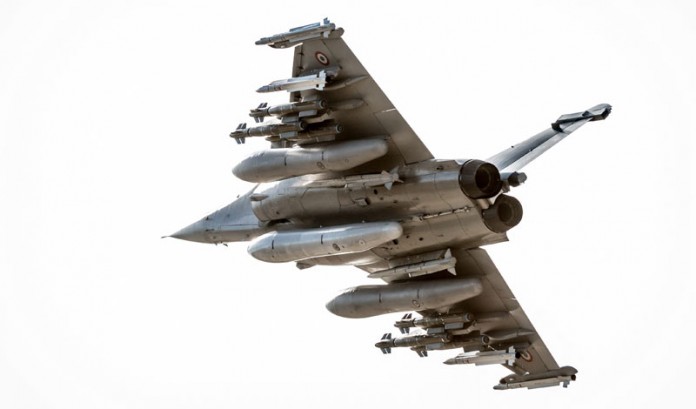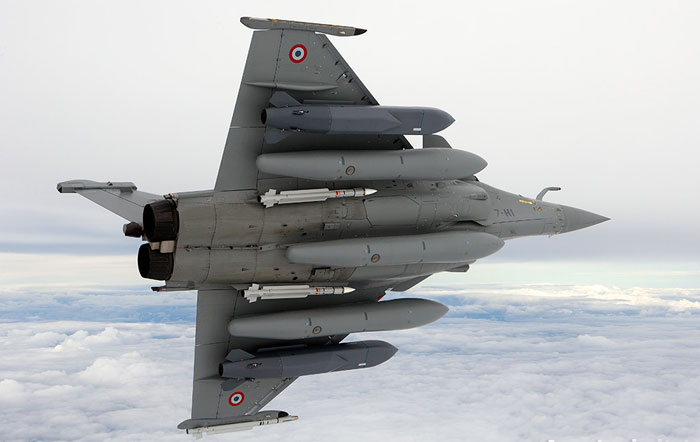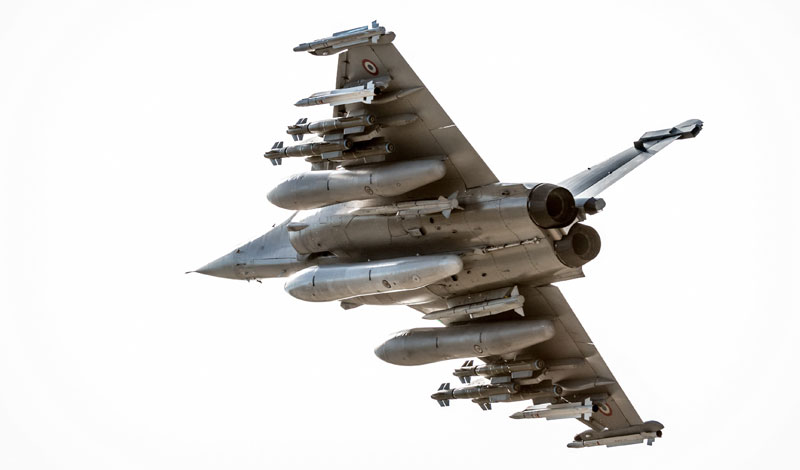Rafale Tested with Maximum Weapons Load – 12 Guided Weapons Underwing

The Rafale has successfully completed its first test flights in a new heavily-armed configuration, comprising
six air-to-ground precision AASM Hammer missiles,
four medium and long range air-to-air missiles from the MICA family, two very long range METEOR missiles, as well as three 2,000 liter fuel tanks. Photo: Dassault Aviation
This preliminary work, self-funded by Dassault Aviation’s are conducted in collaboration with the DGA and will eventually lead to a complete clearance of the flight envelope. Photo: Dassault Aviation
Dassault Aviation has begun testing an upgraded variant of the Rafale configured to carry an expanded configuration of weapons and fuel. This configuration will enable the French strike fighter aircraft to attack more targets and conduct counter-air missions at longer range.
At present, the French military remains the single user of this impressive, but
controversial jet fighter, since
it failed each and every competition except the largest, most lucrative one – the MMRCA competition in India. But Dassault can’t cash in this win,
since even after two years of negotiations the contract with the Indian government hasn’t been signed. The Rafale won that competition after it was selected ‘the lowest bidder’, against the Eurofighter Typhoon. But since its selection its cost escalated sharply and almost doubled, bringing the Indian government, currently heading for election, to develop cold feet about their decision to favor the French fighter.
Nevertheless,
Dassault is committed to bring new capabilities to the Rafale, according to plan, upgrading the aircraft to the Rafale F3-R standard by 2018. These initial tst flights were only the first in a long series, additional test flights are planned to a complete the clearance of the flight envelope for this configuration, providing the
Rafale full multi-role capability at extended range.
Equipped with this configuration,
two Rafale aircraft represent the same potential as six Mirage 2000 class aircraft
This configuration comprise a full increment of
six air-to-air and six air-to-ground weapons. The
air-to-ground ordnance includes six Sagem/MBDA Hammer guided weapons (AASM), carried on
two triple-ejector racks, designed specifically for the weapon. The AASM is deployed with one of three optional guidance methods utilizing a GPS guided, laser homing or thermally guided seekers. To extend its range the
Hammer is also equipped with a rocket booster.
Four MICA air-to-air missiles and two very long range Meteor missiles will be complementing the fighter’s air-to-air capability. The MICA missiles are operational and can be employed with IR or radar guided. These
Meteor missiles
are yet to enter service – but they are
expected to be fielded with the F3-R variant by 2018. In addition to that impressive weapons complement, Rafale will retain its
Nexter 30M791 30 mm internal cannon, firing 2500 rounds/min. According to the manufacturer, equipped with this configuration,
two Rafale aircraft represent the same potential as six Mirage 2000 class aircraft.
Since June 2013 all production aircraft configured to the new F3-04T-standard are equipped with the new radar, along with an improved front sector optronics equipment (also from Thales) and the
DDM-NG passive missile approach warning system, produced by
MBDA.
The weapons would take less than a third of the fighter’s payload – the
rest will be used to carry fuel to sustain the long range missions the fighter is required to perform. The Rafale can
carry up to 9.5 tons of payload (21,000 lbs). To support missions atextended ranges the fighter also
carries three 524 gallons (2,000 litre) fuel tanks weighing additional 6.7 tons (14,700 lbs) that will top up the fighter’s internal fuel capacity of 4.7 t (10,300 lbs). These fuel tanks can also be used for ‘buddy refuelling’,
further increasing the range and mission endurance of a Rafale-based strike force, a capability particularly important for the naval strike missions.

In the current configuration Rafale
carries two Scalp cruise missiles or four direct attack weapons (Hammer/laser guided bombs), with four MICA air-to-air missiles. Photo: French Air Force
In the past the French Rafale could strike deep behind enemy lines utilizing the Scalp cruise missiles, as demonstrated in Libya in 2011. On such missions the Rafales carried two Scalp missiles and three 524 gallon fuel tanks. Other weapons typically carried by the Rafale include GBU-12/24 laser-guided bombs, GBU-49 GPS-guided bombs, AASM and Scalp cruise missiles. On maritime strike missions the Rafale M can also carry the Exocet AM39 Block 2 air-launched anti-ship missile. Since 2010 one of the Air Forces’ Rafale squadrons, EC-1/91 has also assumed the nuclear strike role, carrying ASMP-A missile. By increasing the capabilities of its fourteen hard points, (eight under the wings), with an empty weight of about 10 tons [22000 lbs], the F3 variant is limited to 24.5 tons [54,000 lb.]) thus being capable of carrying 1.5 times its own mass.
Rafale No. 137 was the first to be equipped with Thales’ new
RBE2 AESA radar and the new Front Section Optronics Optronic (FSO-IT) suit. Photo: Dassault Aviation
Clearance of this new configuration was initiated and funded by the aircraft maker Dassault Aviation, in collaboration with the Direction Générale de l’Armement (the French Defense Procurement Agency DGA). According to Dassault, the rapid development of the new configuration is attributed to the open architecture of the aircraft, designed from the outset to perform all of the missions previously assigned to seven different types of aircraft in France.
The Rafale entered service with the French Navy in 2004 and with the French Air Force in 2006. Of the 180 aircraft ordered by France to date, 126 have been delivered. India has also selected the Rafale for its
Medium Multi Mission Combat Aircraft (MMRCA) requirement, planning to order at least
126 of the jet fighters. However, two years after the selection New Delhi has not finalized the contract with Dassault and, pressed by the upcoming elections, the Indians are considering a
limited order of 18 aircraft to be produced in France, as a near-term solution to get the deal in motion.
The defence ministry headed by AK Antony has developed cold feet after the cost doubled compared to the original estimate. With the general elections just months away, Antony is unsure about the fate of the deal, a defence ministry official said. India’s
Diligent Media Corporation (DNA) reports. In January 2012, when Rafale was declared the winner,
its price was quoted between $60-65 million (Rs373-Rs400 crore). Today, according to the , its price could now soar to
$120 million (Rs746 crore). The second bidder,
Eurofighter, had quoted $80-85 million (Rs497-Rs528 crore). The price hike would mean that the deal would cost India nothing less than
$28-30 billion (Rs1.75 lakh crore-Rs1.86 lakh crore) DNA quoted an anonymous Indian Air Force source close to the negotiation committee. In 2007, when the tender was floated, the cost of the programme was $12 billion (Rs42,000 crore). When the lowest bidder was declared in January 2012, the cost of the deal shot up to $18 billion (Rs90,000 crore).
The Rafale fleet with the French Air Force and Navy currently totals almost 120,000 flight hours, including 16,000 in operations. Since mid-2013, production Rafale aircraft are equipped with an active array RBE2 AESA radar from Thales.
Expected to become operational in 2018, Rafale F3-R will be an evolutionary upgrade of the current F3 variant, a part of an ongoing enhancement of the French fighter. Among the improvements are the introduction of
RBE2 active electronically scanned array (AESA) radar, developed by Thales. This radar has already been fielded with at least 60 of the Rafales. The first to get the new radar was aircraft #137, that rolled of the production line in October 2012.
Since mid 2013 production aircraft are configured to the new F3-04T-standard are equipped with the new radar, along with an improved front sector optronics (FSO-IT) equipment (also from Thales) and the DDM-NG passive missile approach warning system, produced by
MBDA.
Another new capability to be integrated with the fighter by 2018 will be the PDL-NG new-generation laser designation pod, currently under development at Thales. Other planned
sensors upgrades related to air-to-surface capabilities include assisted target recognition and enhanced sensor resolution,
enabling the Rafale to attack ever more elusive targets.
According to Dassault, the
ongoing effort will ensure more robust detection, tracking and identification of emerging air-to-air threats, and
increase the Rafale’s survivability with new low observable modes and with the latest advances in electronic warfare systems.

The Rafale has successfully completed its first test flights in a
new heavily-armed configuration, comprising
six air-to-ground precision AASM Hammer missiles,
four medium and long range air-to-air missiles from the MICA family,
two very long range METEOR
missiles, as well as
three 2,000 liter fuel tanks. Photo: Dassault Aviation
http://defense-update.com/20140127_rafale_omnirole_configuration.html
أكملت الرافال اختبار الطيران بالحمولة القصوى :
AASM Hammerستة صواريخ ارض – جو من نوع
MICAأربعة صواريخ من متوسط إلى بعيد المدى جو-جو من نوع
METEOR صاروخين بعيدة المدى جو –جو من نوع
خزانين للوقود حمولة 2,000 لتر
هو الاختبار الوحيد الذى نجحت فيه في الهند MMRCA
Medium Multi Mission Combat Aircraft (MMRCA(
الطائرة ستطور إلى Rafale F3-R
على أن يتم التطوير في 2018
طائرتين من رافال تؤدى عمل ستة طائرات من ميراج 2000
بإمكانها أن تحمل ستة صواريخ جو-أرض من نوع
Sagem/MBDAHammerguided weapons(AASM
تحمل على نقطتين ثلاثيتين ( كل واحدة تتكون من ثلاث نقاط )
two triple-ejector racks
These Meteor missilesare yet to enter service – but they are
expected to be fielded with the F3-R variant by 2018
صواريخ الميتور لم تدخل الخدمة مع الرافال لحد الآن ومتوقع دخولها في 2018
مدفع من عيار 30مم ب 2500 طلقة في الدقيقة - 30M791
DDM-NG passive missile approach warning system
هو نظام الإنذار السلبى في المعركة الجوية
The weapons would take less than a third of the fighter’s payload
الأسلحة التي تحملها هي أقل من ثلث الحمولة الكلية للطائرة
rest will be used to carry fuel to sustain the long range missions the fighter is required to perform.
البقية ستكون لحمولة الوقود مما يساعد الطائرة في أداء مهمتها بعيدة المدى والتي صممت من أجلها.
carry up to 9.5 tons of payload (21,000 lbs (.
حمولتها القصوى تسعة ونصف طن.
its price was quoted between $60-65 million (Rs373-Rs400 crore. Today, according to the , its price could now soar to$120 million (Rs746 crore). The second bidder, Eurofighter, had quoted $80-85 million (Rs497-Rs528 crore). The price hike would mean that the deal would cost India nothing less than$28-30 billion (Rs1.75 lakh crore-Rs1.86 lakh crore(
سعرها في 2012 كان من 60 الى 65 مليون . الآن 120مليون , أما اليوروفايتر سعرها من 80 الى 85 مليون.
صفقة الهند ستكلف من 28 الى 30 مليار .
رافال المطورة والمتوقع دخولها الخدمة في 2018 ستطور الى :Rafale F3-R
RBE2 active electronically scanned array (AESA) radar
رادار الإيسا
Another new capability to be integrated with the fighter by 2018 will be the PDL-NG new-generation laser designation pod, currently under development at Thales.
بود التهديف الموجه بالليزر( تحت التطوير في ثلس)
sensors upgrades related to air-to-surface capabilities include assisted target recognitionand enhanced sensor resolution, enabling the Rafale to attack ever more elusive targets.
تطوير مجسات التهديف جو – أرض لرصد الأهداف الصعبة والمراوغة.

:لايتنج::لايتنج::لايتنج:

:لايتنج::لايتنج::لايتنج:


عبيها بريمستون يا عم احسن





